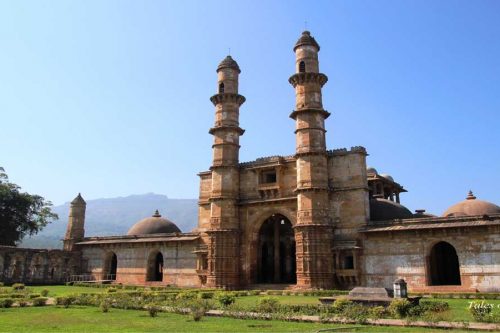A road trip across Vibrant Gujarat is like a treasure hunt but with no clues given. Nonetheless, a very exciting treasure hunt where you keep stumbling upon wonders after wonders. Just take a map with you and ask a little bit around and go ahead explore the lovely land. Better still, ask us because we have “been there and done that” and can help save you precious time and effort. Click here to get in touch.
On one such road trip across Eastern Gujarat, our map led us to this bewildering wonder of a temple – Shree Stambheshwar Mahadev Mandir in Kavi Kamboi, Jambusar. We were literally on a treasure hunt of sorts and were visiting one hidden gem after another. Our minds were still busy processing all the information we received at Balasinor (read here about the Dinosaur fossil site) when we snaked our way through narrow village roads to a spectacle like none other. There stood in front of our eyes in the water of Bay of Cambay a beautiful wall-less orange and white temple that looked like a gazebo from afar. This was the legendary Shree Stambheshwar Mahadev Temple dedicated to lord Shiva. What we were told was that this temple gets totally submerged in the sea at high tide and emerges completely to the bottom at low tide. Of course then how could we not visit this marvel!
The Sight and the Site
There were quite a few visitors here with lots of cars parked around the single road that ends abruptly next to the open land around the temple. A short walkway leads one from this road to the temple. The walkway has a shed over it to protect the devotees from the harsh sea-sun and villagers from around here line the walkway with their wares and knick knacks to sell. Many “holy” symbols such as replicas of the temple, multi-metal rings, vastu-fengshuiesque tortoises, pyramids, evil eyes, charms and talismans, small Shiva Lingas in different stones for the home-temples, pictures of Gods and of course plastic baskets full of Pooja pre-requisites like Flowers, Betel, Incense sticks, Prasad etc are all sold here. Local berries of the season and fresh fruits also have made their way to the walkway!
Beyond the walkway where the temple stands, on the right is a slightly higher temple built for Shiva’s trusted Gate Guardian and “transporter” Nandi the bull. This temple remains unaffected by the tides. The main Shiva Linga stands in the sanctum sanctorum which is a couple of steps down from the main land. This probably is the simplest Shiva temple we have seen so far with nothing except the Shiva Linga and brick tiled floor with iron rails and a wrought iron gate. The gates are opened only when the tide is fully receded revealing the entire length of the Shiva linga as well as the entire floor. You may step down to pay your respects and perform your Parikrama. People from across faiths can be seen here, such is the following of this vanishing temple.
The legend
The legend behind this temple’s coming into existence is as interesting as the temple and the tide phenomenon itself. It is believed that Lord Kartikeya who also is Lord Shiva’s son was quite remorseful after killing Tarakasura – a demon as Tarakasura was a staunch devotee of Lord Shiva. During this remorseful and guilt ridden time he met Lord Vishnu to help him find a way to absolve himself of the sin he felt he committed. Lord Vishnu comforted Lord Kartikeya by first making him understand that the act he deems a sin was actually a service to the mankind as Tarakasura was known to torment the people and secondly by advising him to make a temple for Lord Shiva and by worshipping him everyday. Hence came the Shiva Linga at Stambheshwar that still stands to bewilder us humans.
What else to do
The locale is quite picturesque and photographers can delight in coming here with their gear. The Bay is a vast expanse of bluish grey haze with silhouettes of the settlements across the bay visible from this end. Seagulls and other marine feathered friends hover around diving sometimes to catch a stray fish and sometimes to catch the chips that people fling at them. Not a great idea though, but we did notice people feeding Farsaan to the seagulls and other birds. The entire coastline next to the temple buzzes with activity during low tides – there are pony rides, pony carts, tiny versions of ferris wheels and camel rides available here. A few ATVs also are available for the adventure seekers. Those who want a boat ride, contact the local fishermen whose boats are anchored along the coast. The Stambheshwar Mahadev Temple and its vicinity are a popular picnic spot for the people from around the area. We in fact even saw a few families enjoying their evening suppers on mats they brought along. At low tide, the entire coastline is an expansive play ground.
What to eat
The Prasad offered here is sweetened mawa which, believe us, tastes heavenly! The golden brown sweetened and thickened milk is a common Prasad at most of the Shiva temples. There are hand carts besides the road that leads to the temple offering street foods like Pav Bhaji, Bhel, Samosa, different types of farsaans and Kutchi Dabeli too. Thirst quenchers come in the form of Nimbu Sharbat (Lemonade), local cold drinks (if you have ever had a Kanche wala sharbat while growing up you would know) and the array of cold drinks that the MNCs brought to India. You may also choose to sink your teeth into a slurpy drippy Choco bar or Mango Dolly sold by the ice cream vendors.
The Vanishing Act
As I already mentioned that we reached the destination when the tide had already receded with only a foot of water remaining near the Shiva linga, we could really not witness the whole spectacular phenomenon of “now you see me” and “now you don’t”. Those of you who wish to see this entire cycle of submerging and emerging must come prepared to spend the day here. At high tide the top domes of the temple only can be seen, the pictures of the submerged temple here have been taken from internet while all the other pictures were clicked by us during our visit.
There are so many such wondrous places in Gujarat that a road trip of ten days also proved to be too short even for covering only one-fourth of the state. Then of course, that gives us a strong reason to again pack our bags and go exploring the other three quarters! Wonder, what marvels would we discover next!





